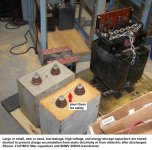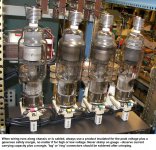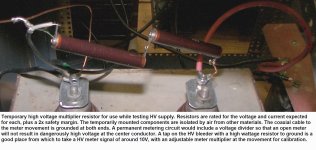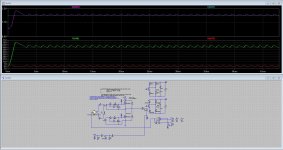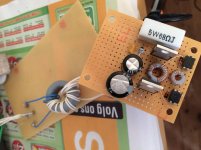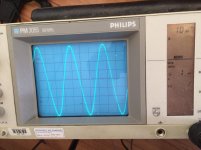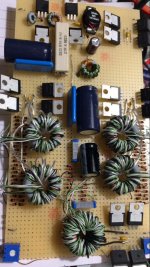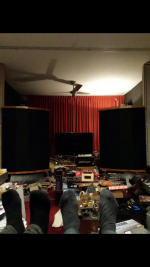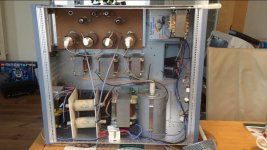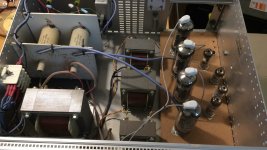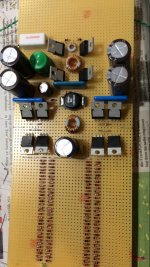In the HV supply for my RF amp, there are 8 450v caps in series with a resistor accross each cap.
Those resistors serve well as bleeders. when turned off, the voltage drops from 2kv to zero in about 45 seconds. Then I take my "chiken stick" and insure that they are fully bled off. The "chikin stick" consists of a 2.5 foot phenolic rod with a 25k resistor at the end. It has served me well over the years.
Those resistors serve well as bleeders. when turned off, the voltage drops from 2kv to zero in about 45 seconds. Then I take my "chiken stick" and insure that they are fully bled off. The "chikin stick" consists of a 2.5 foot phenolic rod with a 25k resistor at the end. It has served me well over the years.
I take it that your chicken stick has a 25 kΩ, 5 watt resistor taped to the end, both leads bent outward, so that it can be placed across each 450 V (only charged to 250 V) individual capacitor?
Once, when I was a 2 KW (plate) HAM, my HV supply had a very high voltage relay that'd release when the mains power went out, engaging a bank of 47 kΩ, 10 W wire wound resistors (I think there were a dozen of them) to discharge the 4 KV supply capacitors. Worked quite effectively. Whether you clicked the power switch off or not, the loss of mains power immediately engaged the bleeder bank. Likewise, when mains power was restored, the bleeder would cut out automatically.
Just saying,
GoatGuy ✓
Once, when I was a 2 KW (plate) HAM, my HV supply had a very high voltage relay that'd release when the mains power went out, engaging a bank of 47 kΩ, 10 W wire wound resistors (I think there were a dozen of them) to discharge the 4 KV supply capacitors. Worked quite effectively. Whether you clicked the power switch off or not, the loss of mains power immediately engaged the bleeder bank. Likewise, when mains power was restored, the bleeder would cut out automatically.
Just saying,
GoatGuy ✓
The "chikin" sticks I've seen (or made) had a resistor at one end with a wire that you connect to the internal power/chassis ground. You connect the ground and touch the resistor to any points that may still have a potential on them. Follow up with an appropriately rated and insulated DVM afterwards to be sure.
Yep, that's it. 😉The "chikin" sticks I've seen (or made) had a resistor at one end with a wire that you connect to the internal power/chassis ground. You connect the ground and touch the resistor to any points that may still have a potential on them. Follow up with an appropriately rated and insulated DVM afterwards to be sure.
I've use these Keystone strips at 600VDC and they work perfectly well...
829 Keystone Electronics | Connectors, Interconnects | DigiKey
829 Keystone Electronics | Connectors, Interconnects | DigiKey
This is a c lever idea, nice reading.
High Voltage can kill you when flow through the heart.
Residual current devices (RCDs) and Ground fault interrupters (GFIs)
regads
High Voltage can kill you when flow through the heart.
Residual current devices (RCDs) and Ground fault interrupters (GFIs)
regads
A dog run thru my amp the other day (i was demonstrating the amp at a friends house) when someone opened the front door. He got so exited, as dogs can get, and kicked out some tubes. Luckily the amp was not powered at that moment. I like hot dog but not in this way.
A lesson learned!
A lesson learned!
Attachments
I worked with 7kv test equipment and locomotive electrical power supplies, but been around 50kv to 600v 3 phase transformers.
The most dangerous thing that I did was to switch 3000hp start up transformers with some argon contactors, then there was a delay and the 5000V would kick in.
It was to power tree shredders.
I was told The biggest motors that you can power are for mining and are around 8kv with 5000hp and they crush stones in a funnel.
I applied there but I was never hired. As long as you understand what you are doing, do not drink on the work and use safety measure, electricity is quite safe on its own.
The most dangerous thing that I did was to switch 3000hp start up transformers with some argon contactors, then there was a delay and the 5000V would kick in.
It was to power tree shredders.
I was told The biggest motors that you can power are for mining and are around 8kv with 5000hp and they crush stones in a funnel.
I applied there but I was never hired. As long as you understand what you are doing, do not drink on the work and use safety measure, electricity is quite safe on its own.
Cool stuff !! I guess that is why it is called “potential” , unless you give it a chance to release all that power it is safe.
Busy with designing, or better reading and then designing a resonant smps for hybrid amp, now busy with filament and HV smps, I was advised a flyback, but I do halfbridge resonant with smaller fets, resonant is much cleaner with EMI and that is better for the amp, smps are nice things make amp smaller. I think for both supplys, there is no need for a regulation, I can use voltage regulators.
Attachments
I also use resonant power supplies with many of my amps and D/A converters. No need for regulators indeed.
Attachments
Nice scope and sticker, the only thing better is one straight from the philips labs.
I have seen your work before Lampie519 and I'm still amazed by the things you make. It also seems like it is cheaper than transformers?
On the HV safety aspect: I shocked myself last week with 400 uF at 380 V because I forgot to put in bleeder resistors. Do yourself a favour and put in those damn bleeders
I have seen your work before Lampie519 and I'm still amazed by the things you make. It also seems like it is cheaper than transformers?
On the HV safety aspect: I shocked myself last week with 400 uF at 380 V because I forgot to put in bleeder resistors. Do yourself a favour and put in those damn bleeders
Be carefull do not get fried!!! Yes, cheaper then regular transformers plus these you can wind yourself without special tools. I have many more projects to come. I want to build a new HV amp for my ESL’s. This time use RF power as well. If you have the chance to try a direct driven ESL’s you wil be convinced of their unheard dynamics and detail. Only big horn loudspeakers can equal on dynamics.
Attachments
Got a few more projects to finish first! Do you have some reading recommendations or fool proof projects, a lot of this stuff seems a bit obscure to find more info on?
4) Discharge all caps.
4) Discharge all caps....
Even though if you do, caps tends to charge back after some times. I discharged my amp with a resistor. After a few hours, I went back for testing only to find 80 volts in that very same cap. Could lead to a very nasty spark.
Also, another day I was desoldering a cap bank in a studio flash base. Even if I had previously discharged it, when the wire opened from the cap, a nasty spark cut my soldering iron tip.
That's when I learned that lesson. NEVER trust a cap to be empty. Discharge it with a resistor, measure it, then place a clip wire to the ground (that you'll remove afterward).
4) Discharge all caps....
Even though if you do, caps tends to charge back after some times. I discharged my amp with a resistor. After a few hours, I went back for testing only to find 80 volts in that very same cap. Could lead to a very nasty spark.
Also, another day I was desoldering a cap bank in a studio flash base. Even if I had previously discharged it, when the wire opened from the cap, a nasty spark cut my soldering iron tip.
That's when I learned that lesson. NEVER trust a cap to be empty. Discharge it with a resistor, measure it, then place a clip wire to the ground (that you'll remove afterward).
- Home
- Amplifiers
- Tubes / Valves
- Safety Practices, General and Ultra-High Voltage


